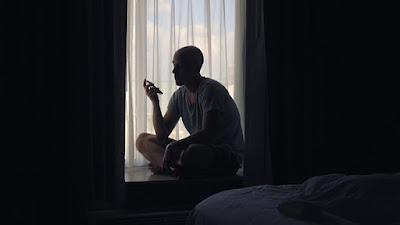Schio's annual street art festival "Sareo" was held in the last week of June 2025. During this festival, the artists living in and around Schio are invited to put up their recent works for display in Via Pasubio in the city centre.
The old name of Via Pasubio was Via Sareo, which explains the name of this festival, which goes back to almost fifty years - it was suspended during the Covid years. The image below shows a view of the street with the art works. (You can click on any of the images below for a bigger view)
I want to share some of the art-works from this year's festival, that I liked. Our response to creative works including art, poetry, books, is very subjective. Thus, I am sure that some of the works that I liked, may not seem special to you and you would have chosen completely different works.
I am very fond of water-colour landscapes but this year, I didn't find any such landscape which I found outstanding. However, I also like abstract compositions and there were a few this year, which I liked.
These artists-artworks are not in any particular order.
Winner of Sareo 2024 - Giannino Scorzato: A jury of artists chooses the best artist, winner of Sareo festivals. Last year's winner was Giannino Scorzato from Valdagno. This year, a solo exhibition of his works was held at the Toaldi-Capra palazzo as a part of Sareo festival.
A self-taught artist, Scorzato is also a mountaineer. He had started with oil paintings, but now he expresses himself mainly in beautiful and amazingly detailed pencil sketches. You can see one of his works from this exhibition in the image below, a portrait of a young girl.
I thought that this landscape by Teresa Vallese captured very well the special light, the landscape and the sea of Mykonos island, with its white houses, with its predominent blue and white colours in a simple way.
I liked the next painting because of its palette of pale colours, the diaphanous-delicate look and the way the flowers and abstract designs foreground the female figure. It is by Antonia Bortoloso from Schio, who is known for her feminine portraits and figures. There were two of her works in this edition of Sareo and I liked both of them.
The next work has Australian aboriginal masks in pointillism style by Raffaella Rigadello - it reminded me of Andy Warhol's pop-art posters because of their colours and graphics. A handwritten note fixed near the artwork, probably written by the artist, pointed about the subjugation of Aboriginal people in Australia by the European settlers.
Mari Baldisserotto's water-colour of a beautiful girl with blue eyes made me think of the photograph of the Afghan girl by Steve McCurry which was used as cover-pic for National Geographic in 1985. I liked its colour composition and the girl's expression.
I like the way Giuseppe (Beppe) Fochesato uses shafts of light in his interiors. He had a few works in the festival and the one I have chosen has an old portico, probably from an old church with a door at the end. I love its colours and atmosphere.
The next is a water-colour by Egidio Carotta and it has a flower-pot fixed to the wall next to a gate. The painting gets its charm from the contrast in the colours of the bricks of the house, where red bricks are used to create a visual impact and give a shape to the painting.
I also liked the delicate flowers in the water-colour painting by Emanuela Minà from Schio. It had beautiful colours and composition. She also had another water-colour painting in the exhibition, but I liked this one more.
The painting of a black galleon ship against an abstract background dominated by green colour, made me think of the film Pirates of the Caribbean and captain Jack Sparrow. I liked its dream like abstract effect. It is by Fabiola Carmelini.
Let me conclude by 3 works which I liked most in this year's Sareo. The first is an abstract composition by Luigi Bernardi. I would have preferred its lower part to be less definite and with paler colours, but still I found it intriguing.
The second is titled "Boy with a neckless" and is by Lorenzo Zanello. I liked its colours and the guy's expression. Every time I looked at it, it made me smile. It also reminds me of a guy I knew.
My favourite piece of art this year was this abstract work by Claudio dal Prà from Chiuppano. I am not able to explain why I liked it but I loved its complex colours, hidden figures and its composition. I like art which pulls me in and I can spend a long time trying to understand why I like it.
Conclusions
I think that it is very difficult for an artist to create a completely distinctive style, so that as soon as you see it you can say that it is by that artist. This also means that when you see works that use that style, you can say that this artist is inspired by that one.
However, developing a distinct style can also become a prison - then people expect you to keep on repeating that style forever. In that sense, creating a style of abstract art is much better because it can give you more freedom as an artist.
Regarding the artists whose works I have presented in this post, I was surprised that only a few of them have a social media presence. I feel that many of them, especially those who have not sacrificed years of life in the pursuit of art and have done other works while keeping art as a passion for the weekends or retirement, feel shy of calling themselves as artists and talking about their art.
*****























































